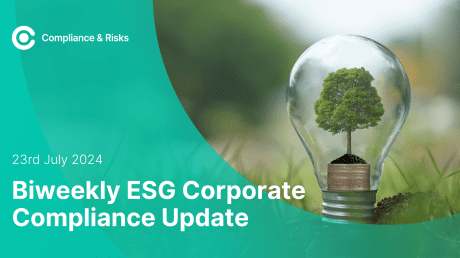
The Weekly Pulse: 5th Sep – 9th Sep

What’s HOT in our Regulatory World at the moment?
What are our clients looking at?
This week’s trending sources in C2P
- Saudi Arabia: Adopting a List of Mandatory and Voluntary Standards, Decision No. 186, 2022
- Sweden: Calculation of Packaging Fees with Regards to Material Recyclability, Draft Regulations, May 2022
- Israel: Energy Labelling of Electrical Appliances Not Marketed in the European Union, Notice, August 2022
What is our Content Team talking about?
US EPA issues Designation of Perfluorooctanoic Acid (PFOA) and Perfluorooctanesulfonic Acid (PFOS) as CERCLA Hazardous Substances – Victoria Smart
Under the Comprehensive Environmental Response, Compensation, and Liability Act of 1980, as amended (“CERCLA” or “Superfund”), the Environmental Protection Agency (EPA or the Agency) is proposing to designate perfluorooctanoic acid (PFOA) and perfluorooctanesulfonic acid (PFOS), including their salts and structural isomers, as hazardous substances.
CERCLA authorizes the Administrator to promulgate regulations designating as hazardous substances such elements, compounds, mixtures, solutions, and substances which, when released into the environment, may present substantial danger to the public health or welfare or the environment.
Such a designation would ultimately facilitate cleanup of contaminated sites and reduce human exposure to these “forever” chemicals.
Comments must be received on or before November 7, 2022.
Under the Paperwork Reduction Act, comments on the information collection provisions are best assured of consideration if the Office of Management and Budget (OMB) receives a copy of your comments on or before October 6, 2022.
The purpose of this proposed rulemaking is to designate PFOA and PFOS, including their salts and structural isomers, as hazardous substances under CERCLA section 102(a).
Upon designation, any person in charge of a vessel or an offshore or onshore facility as soon as they have knowledge of any release of such substances at or above the reportable quantity (RQ) must immediately report such releases to the Federal, state, tribal and local authorities (CERCLA section 103(a), Emergency Planning and Community Right-to-Know Act (EPCRA) section 304).
The RQ for these designations is 1 pound or more in a 24-hour period. Once EPA has collected more data on the size of releases and the resulting risks to human health and the environment, the Agency may consider issuing a regulation adjusting the reportable quantities for these substances.
The five broad categories of entities potentially affected by this action include:
- PFOA and/or PFOS manufacturers (including importers and importers of articles);
- PFOA and/or PFOS processors;
- Manufacturers of products containing PFOA and/or PFOS;
- Downstream product manufacturers and users of PFOA and/or PFOS products; and (5) waste management and wastewater treatment facilities.
The small entities subject to the requirements of this action are:
- Producers and importers of PFOA and PFOS,
- Producers and users of PFOA or PFOS-containing articles, and
- Waste management and wastewater facilities.
What are our Knowledge Partners talking about?
Microplastics, big impact: New EU proposal to restrict microplastics – Cooley
On 30 August 2022, the European Commission published its long-awaited proposal to restrict the placing on the market of microplastics, including where they are added to certain products. The restriction will be adopted under the REACH Regulation, which establishes the EU chemicals framework.
Several categories of products will be impacted by the proposed restriction and very few exceptions are provided for.
As a result, we anticipate that the proposal will have far reaching consequences on a broad range of businesses including those manufacturing and placing on the market fragrances, cosmetics, medical devices and biocidal products containing microplastics.
Below we provide a brief overview of the restriction proposal and what it entails.
What is it called?
Commission Regulation (EU) amending Annex XVII to Regulation (EC) No 1907/2006 of the European Parliament and of the Council concerning the Registration, Evaluation, Authorisation and Restriction of Chemicals (REACH) as regards synthetic polymer microparticles.
What is being proposed?
The proposed restriction provides that synthetic polymer microparticles (“microplastics”) cannot be placed on the market on their own or, where the synthetic polymer microparticles are present to confer a sought-after characteristic (i.e. intentionally added), in mixtures in a concentration equal to or greater than 0.01% by weight.
The restriction will affect the use of microplastics themselves and when they are used in a variety of products, including fragrances, certain cosmetic products, fertilizing products, plant protection products, and biocidal products.
Only certain types of polymers are excluded from the definition of microplastics (e.g. degradable polymers) and only few products are exempted from the proposed restriction (e.g. medicinal products, certain fertilizing products, food additives and in-vitro diagnostic devices).
For specific uses concerned by the restriction, the proposed restriction includes transitional periods aimed at providing sufficient time to concerned stakeholders to comply with the restriction and transition to suitable alternatives, such as degradable polymers. More specifically, the restriction proposal sets the following transitional periods:
- 4 years after the entry into force for the use of microplastics in rinse-off cosmetic products;
- 5 years after the entry into force for the use of microplastics in detergents/waxes/polishes and air care products, fertilising products outside the scope of application of Regulation (EU) 2019/1009, for products for agricultural and horticultural uses;
- 6 years after the entry into force for the use of microplastics in the encapsulation of fragrances, leave-on cosmetic products, medical devices within the scope of Regulation (EU) 2017/745, granular infill for use on synthetic sports surfaces;
- 8 years after the entry into force for the use of microplastics in plant protection products and biocidal products;
- 12 years after the entry into force for the use of microplastics in lip products, nail products and make-up.
In addition to the ban on placing on the market, the proposed restriction introduces information requirements for certain suppliers of microplastics and products containing microplastics.
For example, during the transition period for lip products, nail products and make-up, suppliers will have to include on the label, the packaging, the safety data sheet or the package leaflet the following statement: “This product contains microplastics”.
Reporting obligations will also apply to certain manufacturers, downstream users of microplastics and suppliers of certain products containing microplastics.
Who will it apply to?
The restriction proposal on microplastics will apply to manufacturers, importers and downstream users of microplastics and of products concerned by the proposal.
Why does it matter?
The proposed restriction on microplastics is noteworthy for its wide and general scope. It will not only apply to microplastics as such, but will also impact a broad range of manufacturers of consumer products who will have to modify the composition of their products to become compliant and may have also to comply with new labelling and/or reporting obligations. The breadth of the restriction proposal might make compliance particularly challenging and enforcement even more so, considering the uses concerned.
What are the next steps?
A first discussion on the proposal will take place on September 23, 2022 in the REACH Committee, which is a committee composed of Member State representatives that supports the European Commission on its work under the REACH Regulation. Member States sitting in the REACH Committee will have to vote on the proposal by a qualified majority, before the Commission can send the proposal to the European Parliament and the Council. The European Parliament and Council have a 3-month scrutiny period and, if they do not oppose the proposal during that period, the proposal will be adopted.
What are our Clients asking about?
Has Swiss Federal Office of Public Health revised its ChemO Regulation ? – Answer by Dieudonné Ymedji
This is correct. This partial amendment to the 2015 Ordinance on the protection against dangerous substances and preparations was finalised on 11 March 2022 and entered into force on 01 May 2022. This amendment aims to ensure that toxicological and ecotoxicological data relating to safety of all important substances is made available in Switzerland and to strengthen new substances notification requirements is in C2P under the following name: “Switzerland: Protection against Dangerous Substances and Preparations, Ordinance, June 2015 and others – Amendment – (on substances safety information notification, labeling, etc.) Ordinance, March 2022″.
Stay Updated On Global Regulations
This information is based on the most viewed regulations on C2P this month. If you would like to find out more about how you can stay on top of global regulations, why don’t you Book a Demo with our team today?
Book Time With Our Team
Learn how C2P can help you stay ahead of regulatory changes and achieve uninterrupted market access.








